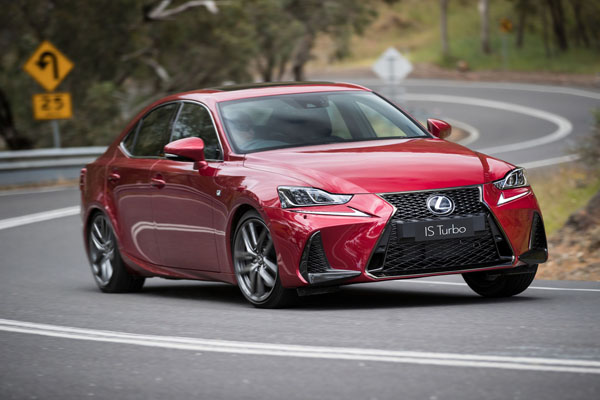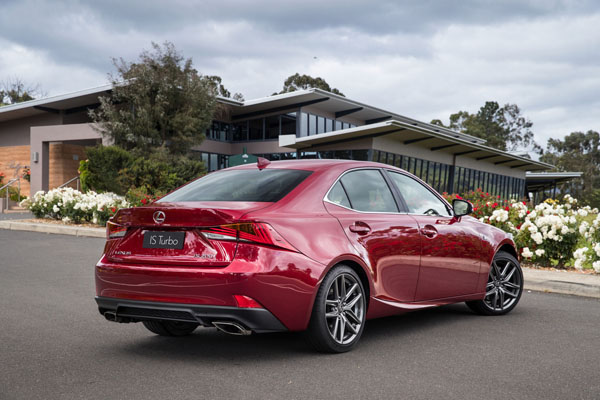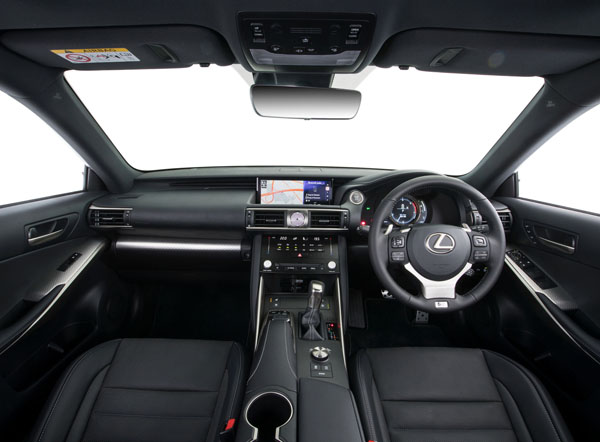 Lexus leaders were left scratching their heads on how to celebrate selling a million IS sports sedans around the world. It did not take long for them to come up with an answer: Let’s make a better one.
Lexus leaders were left scratching their heads on how to celebrate selling a million IS sports sedans around the world. It did not take long for them to come up with an answer: Let’s make a better one.
The result is the new Lexus IS line, which has borrowed from the recently released RC sports coupe, thus creating a four-door version of the well-credentialed two-door.
Closer to home, the resulting major IS upgrades are expected to help Lexus achieve a sales record in Australia of more than 9000 vehicles. Available in three models, each in three grades, with enhancement packages designed to appeal to the individual buyer, all follow the Lexus Kaizen philosophy of continuous improvement.
Included are eight exterior styling changes and 15 inside the cabin, as well as upgrades to the display screen and the unequalled Mark Levinson Lexus sound system. The full suite of Lexus Safety System+ technology, designed to provide maximum driver control, especially in critical situations, is taken up for the first time.
The LSS+ is made up of a pre-collision safety system, active cruise control, lane departure warning+ with sway warning and automatic high beam. All models have 10 airbags, eight-head clearance and reversing sonar, and rear-view camera with guidelines.
All have heated and power-folding exterior mirrors, daytime running lamps, rain-sensing windscreen wipers, emergency brake lamps, hill-start assist, paddle shifters on the steering wheel, Lexus Inform, digital radio+, LCD multi-information display, Lexus remote touch controller, satellite navigation with Suna traffic alerts, heated and ventilated front seats, voice-control multi-media system, pop-up bonnet and tyre-pressure monitoring.
The Lexus IS Line is available as the IS 200t with the recently launched 2.0-litre turbocharged engine, IS 350 using a 3.5-litre quad cam V6 and as the 300h petrol-electric hybrid. All three come in Luxury, F Sport and Sports Luxury levels.
The flagship engine is the 3.5-litre quad cam dual-injection V6 delivering 233 kW of power at 6400 rpm and 378 Nm of torque at 4800 rpm. The innovative turbocharged 2.0-litre engine debuted in the IS Line last year, the first time Lexus has offered a turbocharged petrol sedan.
It is Euro 5 compliant and puts out 180 kW of power at 5800 rpm and 350 Nm of torque from 1650 to 4400 revs. It has official combined urban / highway cycle fuel economy of 7.5 litres per 100 kilometres and carbon dioxide emissions of 175 grams per kilometre.
Both engines are matched to the Lexus eight-speed sequential-shift Sports Direct Shift transmission. The IS 300h hybrid drivetrain combines a 2.5-litre dual-injection twin cam petrol engine and a powerful electric motor mated with a continuously variable transmission with sequential shift-matic six-step control via paddle shifts on the steering wheel. With a combined power output of 164 kW, it uses just 4.9 litres of fuel per 100 kilometres on the combined cycle and puts out 113 grams of carbon dioxide per kilometre.
Redesigned as an ‘Aggressive Sports’ sedan, eight exterior items have been changed, from front bumper and grille, headlamps on all grades, daytime running lamps, rear combination lamps, rear bumper lowered on petrol and hybrid models, muffler tips on IS 350, and wheels on Luxury grade and IS 350 Sports Luxury.
A new front bumper gives the vehicle an extra 15 mm in length, while in keeping with its SUV cousins, the radical Lexus spindle radiator grille has been accentuated even more, which with trapezoidal bumper corners, creates a 3-D contrast that projecting a powerful image.
IS petrol, IS 300h and F Sport each feature a distinct new lower rear bumper design, while petrol models have new, more angular exhaust tips to highlight the promotion to the premium sports league. The bumper, lower on hybrids, now has an exclusive bezel with metallic paint to provide a distinctive premium presence while reinforcing the sporty image. Two new colours – Deep Blue MC, an additional colour, and Graphite Black, which replaces Starlight Black. There are two F Sport-unique colours, Cobalt Mica and White Nova.
Luxury models have new 17-inch alloy wheels with a sculpted five twin-spoke design and bright machine finish to enhance their appearance. Flagship IS 350 Sports Luxury has new bright machine finish 18-inch five-spoke wheels with a contrast between sharp edges and broad surfaces.
New LED headlamps turn inward to bring out their characteristics and enhance continuity with the daytime running lights while sharpening the look. Luxury grades have a single LED low/high beam headlamp and bulb-type turn-signal lamp. F Sport and Sports luxury grades have a three-lamp low-beam system and separate LED high-beam lamp as well as LED signal lamps. Automatic high beam is on all models as part of the Lexus Safety System+.
Lexus has put out a warmer welcome to the IS cabin. Fifteen features have been changed, including upping the multimedia display screen from seven to 10.3-inches, meter hood, clock, centre register, driver and front passenger’s side registers, knee pads, heater control panel, audio panel, Lexus Remote Touch enter switch on two sides, meters, steering-wheel switches, door-trim base switch, shift-lever knob, inside door handles and ornamentation.
The layout of the Multi-Information Display has been improved, and the display area for the odometer/trip meter at the bottom of the MID now has a speed warning. The tab display area at the top of the MID now shows ambient temperature as the default display, with the other displays accessible using the switch on the steering wheel.
The front cup-holder shape has been changed for greater ease of use. Connecting the two cup holders provides space for a mug with a handle, and a mobile phone or smartphone (140 x 70 x 10 mm) can also be stowed there.
Of the three engines, on a launch drive in Victoria, I had use of the 200t, first used last year when IS 200t replaced IS 250. Power has been increased by 27 kW compared with the 2.5-litre V6 and torque to 350 Nm, while improving fuel economy and emission levels. IS 200t, combining an eight-speed Sports Direct Shift automatic transmission with the 2.0-litre turbo engine for the first time, provided driveability expected of a Lexus compact sports sedan. Introducing Lexus Stop & Start technology to IS, for fuel savings in heavy traffic, the system turned out to be one of the better, less intrusive, operators in a field of widely varying standards.
Without being a sensation off the mark, the 200t used its 350 Nm of torque put down through the rear wheels to good advantage from a low 1650 rpm, and cruising effortlessly – and quietly – at just under 2000 revs.
The highly tuned suspension had the sedan skipping through fast bends, while ventilated disc brakes all round made sure the sporty sedan was reined in with a confident assuredness.
Highly tuned, the suspension had the IS 200t ironing out road surface ‘craters’ – there were a few with roadworks cropping up on a regular basis.
The IS 200t won’t let down Lexus lovers in any way. However, those looking for a spicier treat should look at the 3.5-litre V6 to satisfy their desires.
Prices start at $59,340, plus on-road costs, for the entry-level IS 200t Luxury and tops out at $84,160 for the IS 350 F Sports Luxury. The petrol / electric hybrid comes in at $61,890 for the 300h Luxury.
AT A GLANCE
MODEL RANGE
Lexus IS 200t Luxury: $59,340
Lexus IS 200t F Sport: $67,480
Lexus IS 200t Sports Luxury: $78,040
Lexus IS 300h Luxury: $61,890
Lexus IS 300h F Sport: $70,310
Lexus IS 300h Sports Luxury: $81,160
Lexus IS 350 Luxury: $65,390
Lexus IS 350 F Sport: $73,540
Lexus IS 350 Sports Luxury: $84,160
(Most models are available with a range of enhancement packages
as a cost option)
Note: These prices do not include government or dealer delivery charges. Contact your local Lexus dealer for drive-away prices.













